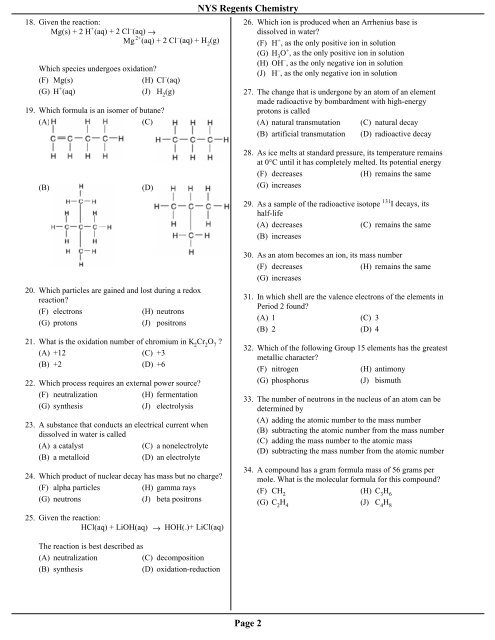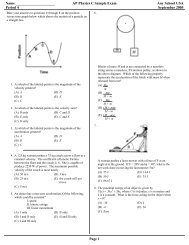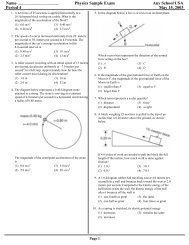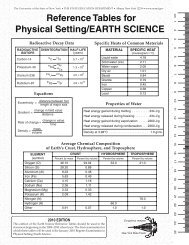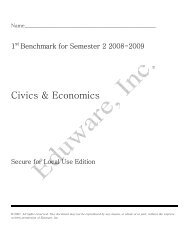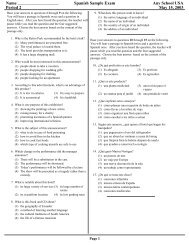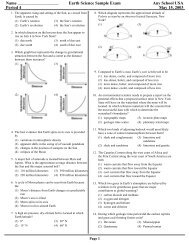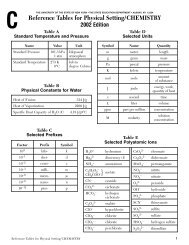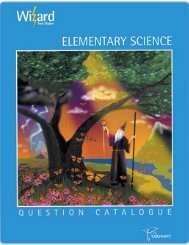NYS Regents Chemistry June 21, 2002 - Eduware
NYS Regents Chemistry June 21, 2002 - Eduware
NYS Regents Chemistry June 21, 2002 - Eduware
Create successful ePaper yourself
Turn your PDF publications into a flip-book with our unique Google optimized e-Paper software.
18. Given the reaction:<br />
Mg(s) + 2 H + (aq) + 2 Cl – (aq) →<br />
Mg 2+ (aq) + 2 Cl – (aq) + H 2<br />
(g)<br />
Which species undergoes oxidation<br />
(F) Mg(s)<br />
(H) Cl – (aq)<br />
(G) H + (aq) (J) H 2<br />
(g)<br />
19. Which formula is an isomer of butane<br />
(A)<br />
(C)<br />
<strong>NYS</strong> <strong>Regents</strong> <strong>Chemistry</strong><br />
26. Which ion is produced when an Arrhenius base is<br />
dissolved in water<br />
(F) H + , as the only positive ion in solution<br />
(G) H 3<br />
O + , as the only positive ion in solution<br />
(H) OH – , as the only negative ion in solution<br />
(J) H – , as the only negative ion in solution<br />
27. The change that is undergone by an atom of an element<br />
made radioactive by bombardment with high-energy<br />
protons is called<br />
(A) natural transmutation (C) natural decay<br />
(B) artificial transmutation (D) radioactive decay<br />
(B)<br />
(D)<br />
28. As ice melts at standard pressure, its temperature remains<br />
at 0°C until it has completely melted. Its potential energy<br />
(F) decreases<br />
(H) remains the same<br />
(G) increases<br />
29. As a sample of the radioactive isotope 131 I decays, its<br />
half-life<br />
(A) decreases<br />
(C) remains the same<br />
(B) increases<br />
20. Which particles are gained and lost during a redox<br />
reaction<br />
(F) electrons<br />
(H) neutrons<br />
(G) protons (J) positrons<br />
<strong>21</strong>. What is the oxidation number of chromium in K 2<br />
Cr 2<br />
O 7<br />
<br />
(A) +12 (C) +3<br />
(B) +2 (D) +6<br />
22. Which process requires an external power source<br />
(F) neutralization<br />
(H) fermentation<br />
(G) synthesis (J) electrolysis<br />
23. A substance that conducts an electrical current when<br />
dissolved in water is called<br />
(A) a catalyst<br />
(C) a nonelectrolyte<br />
(B) a metalloid<br />
(D) an electrolyte<br />
24. Which product of nuclear decay has mass but no charge<br />
(F) alpha particles<br />
(H) gamma rays<br />
(G) neutrons (J) beta positrons<br />
25. Given the reaction:<br />
HCl(aq) + LiOH(aq) → HOH(…)+ LiCl(aq)<br />
30. As an atom becomes an ion, its mass number<br />
(F) decreases<br />
(H) remains the same<br />
(G) increases<br />
31. In which shell are the valence electrons of the elements in<br />
Period 2 found<br />
(A) 1 (C) 3<br />
(B) 2 (D) 4<br />
32. Which of the following Group 15 elements has the greatest<br />
metallic character<br />
(F) nitrogen<br />
(H) antimony<br />
(G) phosphorus (J) bismuth<br />
33. The number of neutrons in the nucleus of an atom can be<br />
determined by<br />
(A) adding the atomic number to the mass number<br />
(B) subtracting the atomic number from the mass number<br />
(C) adding the mass number to the atomic mass<br />
(D) subtracting the mass number from the atomic number<br />
34. A compound has a gram formula mass of 56 grams per<br />
mole. What is the molecular formula for this compound<br />
(F) CH 2<br />
(H) C 3<br />
H 6<br />
(G) C 2<br />
H 4<br />
(J) C 4<br />
H 8<br />
The reaction is best described as<br />
(A) neutralization<br />
(C) decomposition<br />
(B) synthesis<br />
(D) oxidation-reduction<br />
Page 2


